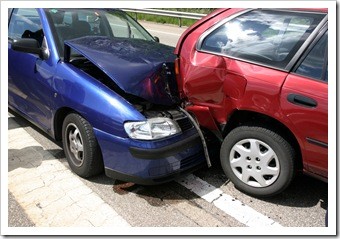 Insurance companies have historically attempted to convince their insureds that accidents with low property damage claims do not justify medical claims. With the MIST (minor impact soft tissue) guidelines, Allstate even went so far as to create adjuster guidelines that segmented out auto accident claims with less than $1,000 damage. Claims adjusters were instructed that, in general, crashes with minimal damage are unlikely to – or cannot – cause significant or permanent injury.(1) This is unscientific nonsense.
Insurance companies have historically attempted to convince their insureds that accidents with low property damage claims do not justify medical claims. With the MIST (minor impact soft tissue) guidelines, Allstate even went so far as to create adjuster guidelines that segmented out auto accident claims with less than $1,000 damage. Claims adjusters were instructed that, in general, crashes with minimal damage are unlikely to – or cannot – cause significant or permanent injury.(1) This is unscientific nonsense.
A number of studies have shown that damaging more than the bumper on a car requires a velocity of 4.8 to 12 mph.(2-9) A car to car impact of 3.1 mph to 6.2 mph has been shown to correlate with a 24% to 40% risk of neck injury.(10-13) Compare these two facts, and one can quickly see that neck injury is likely even when the car has sustained no more damage than a bent fender, if that.
Arthur Croft of the Spine Research Institute and Michael Freeman of the Department of Public Health attempted to collect and synthesize all peer reviewed, scientific studies to assess the validity of MIST type statements. Their results were published in the Medical Science Monitor.(14) They found 12 studies, but excluded eight because of their study criteria which heavily favored the MIST assertion. Their criteria only included data on front and rear impact crashes (because side impacts are associated with higher risk of injury), and only included data from crashes under 25 mph. To further stack the deck in favor of validating MIST, the largest study included in the review only included collisions between vehicles of similar weight and only included vehicles with the safety features of the mid-90’s or better. Despite stacking the data in a way that would favor the MIST position, the evidence led the authors to conclude that property damage is neither a valid predictor of acute injury risk nor of symptom duration.
Farmer and colleagues analyzed 5,083 State Farm claims, and, while statistical significance was limited, they did find that the dollar value of property damage correlates with the risk of injury.(15) However, even studying nothing other than State Farm’s own claims records, they found that property damage of less than $500 correlates with a 20% chance of neck injury and property damage of $500 to $999 correlates with a 27% chance of neck injury. Therefore, State Farm’s own claims records show that one cannot truthfully state or imply that low velocity/low damage auto accidents are unlikely to result in neck injuries. In short, it is our scientifically based, medical opinion that cars are tougher than human necks.
References
1. Koehler K, Freeman M. Litigating Minor Impact Soft Tissue Cases. Philadelphia: Thomson West Publishers, 2001.
2. West D, Gough J, Harper T. Low speed collision testing using human subjects. Accid Recunstruct J. 1993; 5: 22-26.
3. Wolley R, Strother G, James M: Rear stiffness coefficients derived from barrier test data. SAE Internationa Congress, Detroit MI. 1991; 920120.
4. Szabo T, Welcher J: Dynamics of low speec crash tests with energy absorbing bumpers. SAE Tech Paper Series, 1992; 921573: 1-9.
5. Bailey M, Wong B, lawrence J: Data and methods for estimating the severity of minor impaccts. SAE Tech Paper Series, 1995; 950352: 1339-71.
6. Szabo T, Welcher J: Human subject kinematics and electromyographic activity during low speed rear impacts. 1996, SAE paper 962432: 295-315.
7. Siegmund G, King D, Lawrence J, et al: Head/neck kinematic response of human subjects in low-speed rear-end collisions. 1997. SAE Technical Paper, 973341: 357-85.
8. Croft A, Herring P, Freeman M, et al. The nect injury criterion: future considerations. Accid Anal Prev, 2002; 34: 247-55.
9. Cipriani A, Bayan F, Woodhouse M, et al. Low speed colinear impact severity: a comparison between full scale testing and analytical prediction tools with restitution analysis. Accident Reconstruction, 2002; 2002: 23-37.
10. Kraft M, Kullgren A, Ydenius A, Tingvall C. Influence of crash pulse characteristics on whiplash associated disorders in rear impacts-crash recording in real life crashes. Traffic Injury Prevention, 2002; 3: 141-49.
11. Kullgren A, Eriksson L, Bostrom O, Kraft M: Validation of nect injury criteria using reconstructed real-life rear-end crashes with recorded crash pulses. In proceedings 18th International Technical Conference on the Enhanced Safety of Vehicles (ESV) May 19-22; Nagoya, Japan 2003.
12. Bunketop O, Jakobsson L, Norin H: Comparison of frontal and rear-end impacts for car occupants with whiplash-associated disorders symptoms and clinical findings. In International IRCOBI Conference September 22-24: Graz, Austira, 2004; 245-56.
13. Schuller E, Eisenmenger W, Beier G. Whiplash injurys in low speed car accidents: Assessment of biomechanical cervial spine loading and injury prevention in a forensic sample. Journal of Musculoskeletal Pain, 2008; 8: 55-67.
14. Croft A, Freeman M. Correlating crash severity with injury risk, injury severity, and long-term symptoms in low velocity motor vehicle collisions. Med Sci Monit, 2005; 11 (10): RA316-321.
15. Farmer C, Wells J, Werner J. Relationship of head restraint positioning to driver neck injury in rear-end crashes. Accid Anal Prev, 1999; 31: 719-28.
For Your Health,
Dr. Ryan Moorman

 A
A